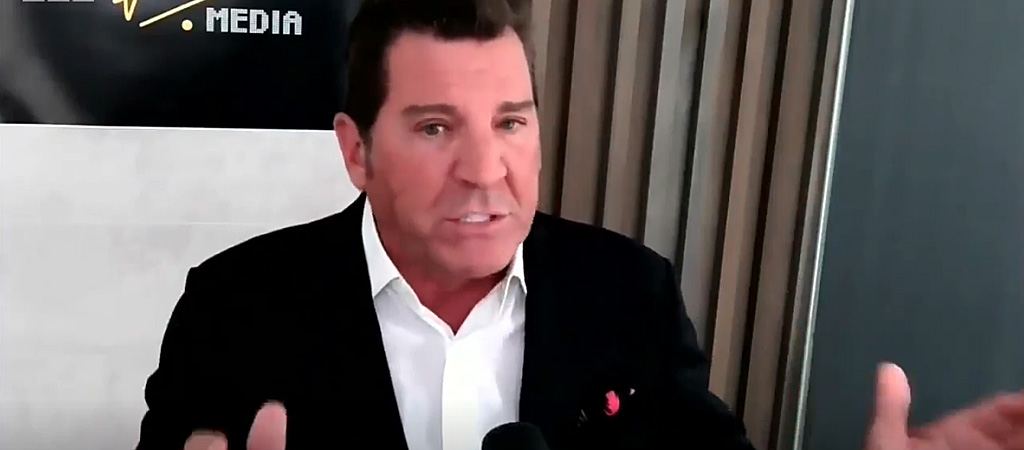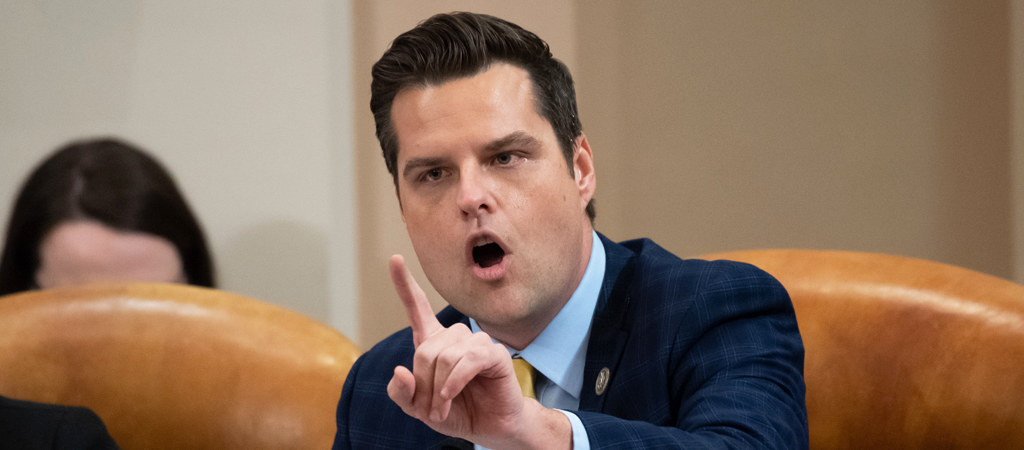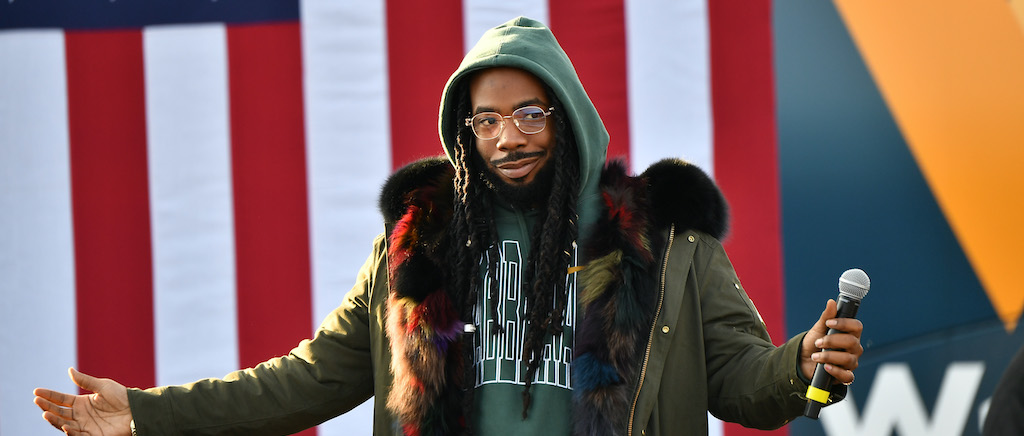
Penei Sewell has been waiting for the 2021 NFL Draft for a long time. As a sophomore at Oregon in 2019, Sewell was voted as the Outland Trophy winner, awarded to the nation’s top offensive lineman, and while he would’ve been a top-10 pick after that performance, he had to wait one more year to be eligible for the Draft. This past season, Sewell opted out due to the COVID-19 pandemic, and has spent the past eight months focusing solely on getting himself NFL ready.
At 6’5 and 331 pounds, Sewell checks every physical box you want in a tackle, and when you toss his game tape, he pops off the screen with the way he dominated the left side of the Oregon line to protect Justin Herbert’s blindside. With quarterbacks dominating the conversation at the top of the 2021 NFL Draft and him sitting out this past season, Sewell has flown under the radar a bit in terms of buzz on a national scale. He’s fine with that, though, as he’s been putting in the work daily to transform his body, hone his technique, and ensure that he’s ready to step in and make a difference for a team immediately.
Sewell recently sat down with Uproxx over Zoom on behalf of Eastbay, as he’s the star of their “Clocking In” series, which takes fans into a day in the life of Sewell and his various workouts in preparation for his move to the NFL. We talked about how those workouts, having his brother around to push him, trying to balance maintaining weight and strength while maximizing quickness and athleticism, working on technique and using inside hand placement more, what he sees people get wrong most when trying to evaluate offensive line play, and much more.
What has the last year been like for you as you’ve been in draft prep mode now for eight, nine months now? What have you been working on and what has it allowed you to do focusing solely on on yourself and getting yourself to be as ready as you can for the NFL?
Yeah, this past year I’ve had nothing but time, so just like you said, I’ve been really focusing on myself. Coming out here to Proactive [Sports Performance] and working out and also trying to really change my body in a way that I know it’ll benefit me once I have the opportunity to play in the league. So just getting with Ryan Capretta and Andy, just trying to see where my limits are and how far I can take my body composition to a level that I don’t know but I want to experience. So, just been doing that and also been trying to get ready football wise. Trying to get with NFL guys, past NFL players or NFL coaches that’s been in the league and knows what it looks like, trying to build knowledge and collect as much knowledge as possible, so that when it’s my time I’ll be ready. So that I don’t have any hesitation on the field and I can play fast and clear minded and go out and do what I do and have fun while doing it.
When you got there, what was the plan from the beginning? You mentioned you wanted to transform your body, and it’s interesting because when you’re in the season, you’re always just kind of trying to get it from game to game and maintain your health. Having a full year to really just focus on transforming your body, what are the things that you feel like you’ve been able to do that maybe otherwise you wouldn’t have had an opportunity to?
I think almost everything, to be honest. The before and after pictures that they took of me is actually incredible. From my chest to my legs, really everything that I wanted to work on, I’ve accomplished, and it was just from simply just trying to look good. Also to be 331 and try to maintain that weight to whatever that looked like. I wanted to make it look good and make it look to where I can move easily and not look where it’s like a struggle, or it’s like a job to really carry that weight.
Yeah, when you watch your film your movement has always been something that pops, whether it’s in pass pro or in the run game. What is the balance that you have to strike to have the ability to move like that, but also carry the weight and carry the strength that you need to hold up when bigger guys shift out and when you have to deal with some of these big defensive linemen that you’re going to in the NFL?
Yeah, so obviously the weight does help. In certain cases, specifically the run game, you have to have a lot of weight behind you to really create that momentum to really go forward. That’s a lot of weight and force coming out a person. But when you’re talking about pass pro, yes you’re trying to really almost finesse and try to stay in front of the defensive player as much as possible. So a lot of reps have to go into it in the offseason and with the coaches. Every time I have the chance, I’m repping more than I have to, because I know that the way I carry [the weight] is not normal. To be comfortable with it, endless reps are needed, and then to be comfortable to be successful in the blocks.
At 331 pounds, Penei Sewell runs a 5.09 40-yard dash
pic.twitter.com/SGVEPsRL8X— PFF Draft (@PFF_College) April 2, 2021
With this Eastbay “Clocking In” video, watching your episode you take us through a day in your training. What are you hoping that people get to see about you and not just the work you’re putting in but also to learn a little bit about yourself as a person?
Yeah, so this video, I wanted to really share myself just to share my story to really let people into my life and see what it’s like to be me, and what it’s like for the people around me. I just wanted to share that with everybody and wanted to show them that I’m working too. A lot of people think that during this time of sitting out that I may not be doing anything or just kind of be chilling and just waiting for the NFL, but that’s not the case. I wanted to show that I’m out here doing the work. I’m coming in each and every day showing that I want this and this is something that I really love and enjoy. And every day, I want to show that, and also the passion behind this game. I don’t think people understand what the love and passion that I have and how deep this game runs into myself, into my family. So I just wanted to share that with everybody and hope they understand after this video.
You mentioned the family aspect, and you’ve got your brother with you. What does it mean to you to be able to do this with him and just have somebody else pushing you. In the video he says he always wants to do an extra rep than you because you’re gonna be the first round pick, and what is it like having that kind of support with you and somebody to push you like that?
Man, it makes it easier. This process definitely has been easier since we’ve been here. He’s big bro, so he’s been there for the whole process for me, trying to help me trying to — really, again, be a big brother. So having him there throughout the whole time, it was just easy. I could go to him about anything and he also he can come to me, and then also if I’m in need of anything that no one else can offer but a big brother, it’s right there. So having him there has been taking a lot off my plate, and also made me realize how fortunate I am and blessed I am to have him here.
In the video they show you working on some techniques stuff. What have been the focuses for you in terms of your technique as an offensive lineman and the areas that you feel like you’ve been able to improve over this past year?
Yes, exactly. So at times I do love to have my hand on the outside just because it changes it up, it gives the defender a different look, and also gives something new. And, yeah, to have the inside hand too, it just again adds to your toolbox and it makes the defender stays on his toes and not really predict what I’m going to throw at him.
How do you work on scheme versatility? Because obviously you don’t know exactly where you’re going to go in the Draft, so you don’t know exactly what the team that you’re going to be playing is going to be asking you to do necessarily. What are the things you do to make sure that you’re working on being somebody who can play in whatever scheme that you’re drafted into and making sure that you’re comfortable when you get in there?
Honestly, I can say that at the end of the day football so, I mean, they’re all the same thing it’s just a different terminology. So, when I come into a place and wherever I go, I immediately just get into the playbook and go from there. I pick up things pretty fast when it comes to football, just because I’ve been around it my whole life. Like I’ve said to multiple people, the first thing I could ever remember is a football. As a kid I was not drawing pictures, I was drawing football plays. So just, it’s so easy for me to pick up anything football wise just because it’s been my passion, it’s always been in my life that anything that’s taught or anything that’s really explained, it just sticks.
Offensive line play I feel like it’s something that for a lot of people is a foreign concept and they don’t really recognize what’s going on. It’s something that isn’t the first thing that a lot of people look at when watching a game. When you look at Xraft evaluations and what people have said about you, what are the things that you think people get wrong the most when they’re evaluating offensive line play that you look at and go no like actually it’s like this?
[laughs] I mean it could be numerous things. Offensive line play, again, it’s so unique. You’re put into body positions that nobody else on the field is. And so, when it comes down to it, I think it just comes down to technique, ultimately. How your knees are inside your body, again going back to hand placement. Also, eye discipline and really being a student of the game.
Speaking of being student of the game, what’s the film work that you do like and how much do you get into that? Has that been a part of your process this last year of trying to kind of pull things from your own film and also looking ahead at what defenses are doing in the NFL to get ready for what you’ll be facing?
Yeah, every chance I have to really watch some film, I take it. Whether it’s my college years in the past or even the college boys back right now, or I’ve gotten with my agent and he’s given me some NFL access on some of the film in the league. So right now I’ve been watching a lot of NFL tape. In my college years, my routine would be at least three hours before I go to bed and an hour when I wake up in the morning before practice. So, watching film is something that is very important to me, because it creates no hesitation in my mind when I step in between those lines that I know what my job is and I know what I’m doing. So I can go out there and really just play fast and have fun with it and not really be stressful about it.
You played with Justin Herbert and he had a spectacular rookie season down in L.A.
Yeah.
Have you been able to talk to him and other guys that you’ve played with who are now in the NFL about what that transition period is like and how to make sure that you come in and you can have that kind of impact like he did as a rookie.
Yeah, with my teammates I’ve talked to Justin Herbert and Shane Lemieux mostly. Here and there I hit him up. I know they’re busy, they got things going on, but yeah, they give me tips, as I asked what’s the league like. What’s hardest thing to really transition into when you’re in the league, and so on and so forth. So they really have been helpful to me throughout this whole process and I’ve also hitting up other O-linemen, like Jedrick Wills and Mekhi Becton. Those two, I try to hit up and try to really pick their brains too and see what their perspective was on their season.
Is there anything specifically that those two guys have been able to tell you about the difference in playing line in the NFL compared to college and things to be ready for in that aspect?
Yeah, it’s different, obviously everybody knows that day in and day out, you’re going against the best. So physically you just got to be ready and mentally. So it comes down to those two. So getting your body right in the offseason and also getting your mind right in the film room and watching as much film as possible.
Something guys have have told me over the years is that one of the most difficult things in making the transition is you have more time on your hands and you have to learn to self schedule yourself in a new way, as college has more regimented scheduling with classes and everything. What have you learned about that and making sure that you’re staying disciplined over this last year, because you’ve experienced that yourself in making sure that you keep focused and you’re not letting any outside distractions in on what you have to do?
Yeah, so that’s something, again, I had to adjust coming off of my college years and coming into this draft process. All the time that I’ve kind of filled it with is just playing video games. Other than that, if I’m not playing video games with my brothers, I’m either in the film room watching film by myself or with my coaches, or working out, obviously, and then getting PT or some type of recovery. With those things going hand in hand, and also playing video games and also being busy with all this media new stuff — this is so new to me, and it’s been stacking up back to back to back, and also talking to the teams, my time is filled right now. But once I get onto a team I’m going to have to find a new routine so that’ll be another journey that I have to pass.
Lastly, what our team’s telling you that they see from you and anything they’ve pointed out to say, like, ‘we want to see this from you,’ in your conversations with teams as you as you get closer to draft day?
I think it’s same thing of what I was trying to work on and I’ve told you about that, it really comes down to my hand placement. Everybody says my feet are good and that my feet can put me into positions and really put me in a place to be successful when my hands are not position. So, if I could put my hands in position and really lock in on that, it’ll help me a lot when coming into the league and it’ll help me be the player I want to be and go on from there.









